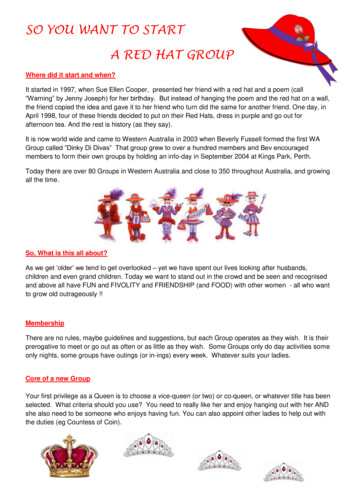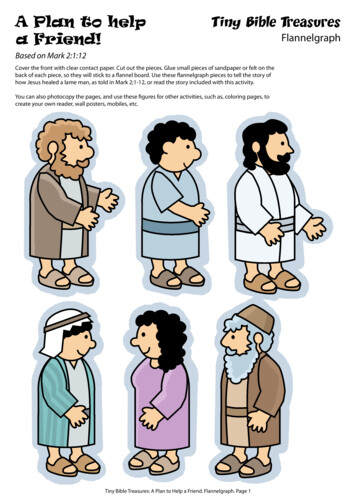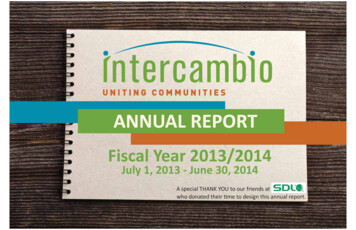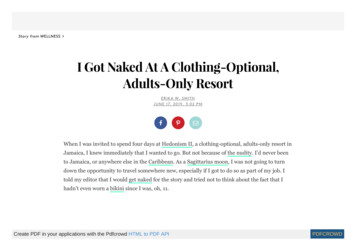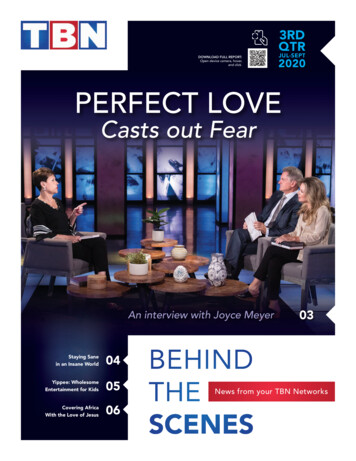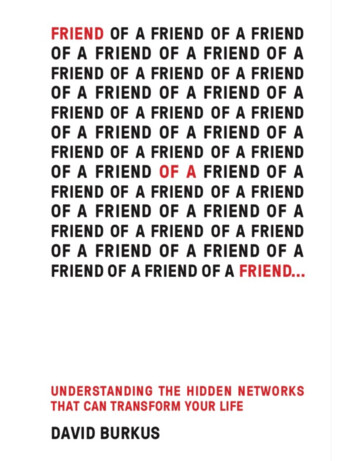
Transcription
F R I END O F A F R I E N D . . .
A L SO BY DAV I D BU R K USUnder New Management:How Leading Organizations AreUpending Business as UsualThe Myths of Creativity:The Truth About How Innovative Companiesand People Generate Great Ideas
F R IENDOF AF R IEND.Understanding the Hidden NetworksThat Can Transform Your LifeDavid BurkusHoughton Mifflin HarcourtBoston New York2018
Copyright 2018 by David BurkusAll rights reservedFor information about permission to reproduce selectionsfrom this book, write to trade.permissions@hmhco.com or toPermissions, Houghton Mifflin Harcourt Publishing Company,3 Park Avenue, 19th Floor, New York, New York 10016.www.hmhco.comLibrary of Congress Cataloging-in-Publication DataCIP data TKBook design by Chrissy KurpeskiPrinted in the United States of AmericaDOC 10 9 8 7 6 5 4 3 2 1
To my parents
ContentsIntroduction11. Find Strength in Weak Ties2. See Your Whole Network13353. Become a Broker and Fill Structural Holes4. Seek Out Silos52715. Build Teams from All over Your Network6. Become a Super-Connector1067. Leverage Preferential Attachment8. Create the Illusion of Majority9. Resist Homophily12314115810. Skip Mixers — Share Activities Instead11. Build Stronger Ties Through MultiplexityConclusion 209Going Further 216AcknowledgmentsNotes219Index234About the Author91217235174192
IntroductionOrHow I Learned to Stop Networkingand Love Network ScienceIn 1999, a young computer engineer and aspiring entrepreneur named Adam Rifkin was looking for advice on hisnext move. In gathering advice, Rifkin sent an unsolicited emailto a man he had never met in person named Graham Spencer.At the time, Spencer was one of the hottest names in the SiliconValley tech community, having just completed the sale of his laststart-up, Excite.com.1Although Excite.com is still active, it’s easy to forgive anyonewho doesn’t immediately recognize the name. In the age beforeGoogle and Facebook, however, Excite was one of the biggestbrands on the Internet. Started in 1993 by Spencer and five of hisfriends, Excite had grown to become the front page of the Internetfor a significant percentage of web-surfers. (This was back whenpeople still used that term seriously.) Spencer and the Excite teamhad grown the website from a humble start-up to a vast collectionof websites. They had some financial struggles, but the successof the website in drawing users eventually led them to a majorpayout. In early 1999, Excite was sold to the telecommunications
2INTRODUCTIONcompany @Home for 6.7 billion. Needless to say, once the dealwas finalized, Spencer was getting a lot of attention.That Rifkin sent a cold email hoping for some advice from aSilicon Valley success story isn’t unusual; who wouldn’t at leasttry? What is unusual is that Spencer agreed to the request. Notonly did Spencer volunteer to meet with Rifkin in person andanswer any questions Rifkin had, but he went above and beyondthat. Once Rifkin had explained his idea, Spencer connectedRifkin to a venture capitalist who became one of the first fundersof the new start-up.The overriding question is why, at the height of his popularity,and at the peak of the demand for his time, did Spencer agree tosit down with someone he had never met in person?Because five years earlier, Rifkin and Spencer had built awebpage about punk rock bands.More specifically, in 1994, as Rifkin was beginning his studies in computer science, he built a fan website dedicated to theemerging punk rock band Green Day. Despite it being the earlydays of the Internet, the website took off quickly. In fact, thewebsite was getting so much attention that members of GreenDay asked if they could take it over from Rifkin and make ittheir official website. Rifkin said yes. But Rifkin also received another request, from a young Graham Spencer, who felt that labeling Green Day as “punk rock” was taking attention away from“real” punk bands. So Rifkin and Spencer worked together andbuilt a page on the Green Day website that listed other, lesserknown bands. “A completely random set of events that happenedin 1994 led to re-engaging with him over e-mails in 1999,” Rifkinsaid. “Which led to my company getting founded in 2000.”2Rifkin had helped Spencer, even though he could have ignoredthe request. Five years later, Spencer in turn helped Rifkin eventhough he too could have ignored the request.
INTRODUCTION3While this story might seem exceptional, it’s actually not thatuncommon an occurrence for Rifkin. His career has been full ofincidents of helping individuals who either were or would go onto be well-known figures in technology and business. Like thetime Rifkin gave some contract work over to a young Ev Williams so he could keep afloat with a start-up called Blogger —which he later sold to Google for an undisclosed sum (thoughrumors estimate tens of millions). Williams would go on to startthe company that would become Twitter. Or like the time Rifkinwas starting another company and needed office space, and ReidHoffman offered to let his team crash at LinkedIn until they goton their feet.3Rifkin’s story is filled with amazing anecdotes. He may not bea well-known name to everyone, but to the right people in his industry, he’s more than well known. He’s the best networker inthe world. Literally. In 2011, Fortune magazine named Rifkin“the world’s best networker” — since it turned out that he wasmore connected than anyone else to the most influential peopleon Fortune’s lists (Fortune 500, 40 Under 40, 50 Most PowerWomen, etc.).4What is surprising about Rifkin earning this title isn’t just thathe is not the household name we would expect, but also that hedoesn’t fit the image of the world’s best networker. He is nota tall, extroverted, dapper, energetic, eloquent, highly educatedprofessional. “I am not an extrovert,” he has said frequently.“Meeting people is not my favorite thing.”5 He describes himselfas a little shy and awkward. He prefers a T-shirt and hoodie to asuit and tie. His look is often compared to a panda bear (a comparison he wears fairly proudly). He’d rather reconnect with oldfriends than work a room full of new people.What Rifkin does have is an understanding of how networkswork. Much of his initial strategy for building relationships and
4INTRODUCTIONmaking connections wasn’t gleaned from an advice book aboutbeing a power networker. It came from his graduate school workin computer science. “I feel fortunate to have learned networking from many excellent teachers,” Rifkin once said. “And thegreatest of these teachers was actually the Internet itself.”6 ToRifkin, human networks follow similar principles to computernetworks. And studying those networks taught him several lessons about how to build and utilize better human networks.While we might think of our network as a collection of contactcards in a rolodex (or more modernly, a collection of names in acontacts app), when Rifkin thought about networks, he saw themnot as a collection of contacts but as the map of the connectionsbetween contacts. “A network is basically a set of people and theconnections between those people,” he explained.7One lesson in particular was that computer networks grow invalue as the number of nodes and the number of connectionsgrow. (A similar lesson from network science, often referred toas Metcalfe’s Law, is a mathematical expression of this idea.) “Ifyou go about it the right way, then it’s good for everyone,” Rifkinexplained. “If you go about it the wrong way, then it cuts off opportunities, not just for yourself but for others too.”8 So Rifkincommitted himself to making introductions every single day.Eventually, he learned to scale his network building by buildinga whole community, 106 Miles, dedicated to keeping the techcommunity well connected. Today 106 Miles has almost 10,000members who interact regularly. It’s a network unto itself. Although Rifkin isn’t at the center of it anymore, it owes its existence to his perspective on networks and networking.Rifkin’s own extensive network, and the career success it hasbrought him, is more than an amazing story. It’s a stern rejection of many of the misconceptions about what networking isand how it’s supposed to work. One reason these misconceptions
INTRODUCTION5are widespread is that the majority of books, workshops, courses,speeches, and more on the subject are based on old and misguided advice. Specifically:fThey say you should write and refine your “elevator pitch.”fThey say you should never eat a meal alone.fThey say that you should repeat someone’s name threetimes in the first few seconds of conversation (sometimesas advice for remembering the name, other times as atrick to get people to like you more).fThey will offer guidelines on how to work a room or how tomeet new connections online.But all advice is autobiographical.9 Advice, even advice aboutnetworks, represents little more than one person’s single storyprojected onto others. Advice, at its core, says, “I did this and itworked, so you should do it too,” or the slightly more convincing, “I wasn’t doing this, but then I did and it changed my life.”As well meaning, inspirational, and accurate as another person’sautobiography might be, it’s still one person, with one specificset of skills, one personality, in one specific location, at one specific time. So what if you’re not that person with that personalityat that point in life? What if you’re not the tall, extroverted, dapper, energetic, eloquent, highly educated professional who’s giving you the advice? Would it still work for you? Would you evenwant to try it?Many people report feeling sketchy or even dirty when they engage in or think about networking. We think about the creepysalesman at the last networking mixer we attended, the one whosped around the room handing out business cards like candy andalways scanning for people more “important” than us to talk to.Or we think about that old classmate who just hit the job market
6INTRODUCTIONunexpectedly and has started frantically emailing everyone in heraddress book, blanketing LinkedIn with connection requests,and asking just about everyone out for coffee and a “quick chat.”Networking seems to many of us to be an insincere way to manipulate relationships for personal gain. This is the repulsive stereotype most people have of networkers, and it’s no surprise thatit is not a pleasant picture.In one study, the researchers Tiziana Casciaro, FrancescaGino, and Maryam Kouchaki found that even just thinking aboutnetworking leaves most people feeling dirty . . . literally dirty.10In one round of the study, the researchers asked 306 adults toremember a time when they reached out to form a new relationship. One group was asked to imagine a time when they soughtout professional contacts who could help their career (what theresearchers called “instrumental networking”). Another groupwas asked to imagine a time when they reached out to someonein their industry to form a personal connection, without consideration of professional gain (what the researchers called “personal networking” but we could also label “being a decent human being”).Afterwards, participants in both groups were asked to do aword completion task and given word fragments (such as “SP” or “W H”) that could be filled in to spell seemingly random words (“STEP” or “WISH”) or words related to cleanliness(“SOAP” or “WASH”). It has been well demonstrated in previous research that feeling morally tainted increases our desire forcleanliness and that desire manifests in subtle shifts in cognition— including how we do a word completion task. Unsurprisingly,Casciaro and her colleagues found that those in the instrumental networking group — those who had to imagine a time whenthey played the role of the stereotypical networker — completedthe task with words related to cleanliness. The implication is that
INTRODUCTION7the act of networking made them feel morally tainted and literally dirty.In a follow-up round, the researchers took the experiment online. They asked students to think of a time when they had reachedout to get to know someone better. One group of students wasasked about social connections and the other about professionalrelationships. The researchers then asked the social group toreach out to the person they were thinking of via Facebook (asocial media website mainly used to build and maintain friendships), and the professional group was asked to reach out to theperson they had remembered via LinkedIn (a social media website mainly used to build and maintain professional relationships).Afterwards, all students were surveyed about how they were feeling. Again, the professional relationships group reported feelingphysically dirtier than those in the social relationships group.Despite these results, Casciaro and her colleagues also foundthat networking was hugely important. In a different study, theysurveyed hundreds of lawyers throughout North America andasked them how frequently they engaged in networking. Theyfound that those who engaged in making new connections andstrengthening old ones were better performers (in terms of billable hours and hence compensation) than those who didn’t.Their findings align with a significant body of research that demonstrates that networking — making and strengthening connections to others — is vitally important for professional success.Likewise, understanding how the networks inside an organization truly operate dramatically improves its overall importance.But what do you get when you combine an understanding thatnetworks and relationships are important with the commonlyshared belief that networking activities are awkward and dirty?You get perhaps the most commonly expressed maxim aboutnetworking: “It’s not what you know; it’s who you know.”
8INTRODUCTIONThis phrase is a curious one. People have written it down orspoken it aloud for at least seven decades (and probably more thanthat),11 but usually just to express exasperation. “I didn’t get thejob [the sale/the promotion] because I didn’t have the right connections.” You may have even said it yourself at some point — in amoment of similar frustration. If success is mostly a matter of whoyou know, then we start to believe that we only have two choices:settle for less, or adopt the stereotypical networking prowler.But what if there is another choice?In fact, there is.Researchers Rob Cross and Robert Thomas have found timeand again that “who you know” is important, but just knowinglots of people won’t get you there. “In fact, we’ve found that individuals who simply know a lot of people are less likely to achievestandout performance,” they write. “Political animals with lots ofconnections to corporate and industry leaders don’t win the day,either.”12 Collecting contacts isn’t the surefire route to success.In light of this research showing that it’s not necessarily aboutwho you know, perhaps another commonly used phrase is moreaccurate: it’s about knowing who is a “friend of a friend.” It’sabout getting a full picture of the network you already have access to, and learning how to improve it.Like Adam Rifkin, understanding how networks work, how tonavigate them, and how to tend to the community they representis what determines a lot of your career success and a lot of organizations’ ability to perform. Knowing who your friends are andwho their friends are, so you can gain a better understanding ofthe community, will lead to better odds that your network willenhance your success.Fortunately, this insight is backed up by decades of researchfrom the worlds of sociology and network science. This researchsupports that being connected to a strong network provides ma-
INTRODUCTION9jor advantages — access to diverse skills and perspectives, theability to learn private information, and the type of expertise andinfluence that makes it easier to attain power — which sociologistsrefer to as social capital. An intriguing term that appears to havebeen invented by six different people at six different times, social capital takes its definition opposite physical capital — financial resources, inventory, property, and the like.13 Just as thosethings have value, sociologists argue, so do the connections andnetworks of our social capital — especially when we know howto leverage that capital. In one study, led by the renowned sociologist Ronald Burt (more on him soon), it was found that educating executives about network structures and principles led todramatic improvements in performance.14 Those who took thetraining were 36 to 42 percent more likely to improve their performance than similarity qualified but untrained peers, and 42 to74 percent more likely to be promoted.And that is what this book is about.This isn’t just a book about networking. It’s not like any networking book you have read (or ignored) before. This is a bookabout how networks actually work. This isn’t another collection of rote advice and specific instructions on how to meet newpeople or how to work a room. It’s not a manual for managingyour social media and online presence. There are plenty of thoseguides already and adding one more wouldn’t help — especiallybecause just collecting contacts doesn’t work. Instead, this is abook that takes a deep dive into the proven science of networksand shares the implications for anyone looking to upgrade theirconnections and relationships.I won’t be sharing anecdotal advice from stereotypical networkers; instead, we will examine real case studies of people andcompanies who found success because they found (knowingly ornot) a strategy in line with the research.
10INTRODUCTIONKnowing how networks come together is the secret weaponbehind a powerful networking strategy. It works better than theentire collection of tools.And that is where we are headed.The next chapter explains the types of network connectionsthat are most likely to provide you with new information and opportunities (and a quick hint: it’s probably not who you tend to interact with the most). After that, chapter 2 examines an old partygame and reveals the clues it holds to just how large and usefulyour total network really is. Chapter 3 deals with your networking strategy: is it better to try to connect with everyone in one industry or profession, or is it better to be the connector betweenthese groups? Chapter 4 answers the common call to break downsilos with a reminder that sometimes staying in your silo can havetremendous benefits — it just depends on how often you’re there.Chapter 5 examines how your network affects the teams you relyon, and explains why part of cultivating a high-performing network is being willing to decrease or cut off how frequently youinteract with some connections. Chapter 6 describes just howlarge your network can become, and how above-average networkers really do have above-average networks. Chapter 7 looksat the implications of above-average networks for your own plan:will it always be an uphill battle and a constant process to makekey connections, or can you grow your network passively?Then we turn to some of the more surprising findings fromnetwork science that will have you reevaluating your entire network. Chapter 8 describes an intriguing quirk of social networks:it is possible to appear more popular and connected than you really are — but is it worthwhile? Chapter 9 issues a dire warningfor anyone building their network: more isn’t better if it meansmore of the same. Chapter 10 reveals the solution to this dilemma, showing that where and how you make new connections
INTRODUCTION11affect how valuable they will become. Chapter 11, the final chapter, moves away from the entire network to look at individualconnections, revealing that part of “who you know” includes how(and how well) you know them.In addition to the implications for individuals, the findingsfrom network science carry implications for how leaders shapetheir organizations and how companies try to market theirbrands through customer networks. When relevant, these will beexplored as well.To help you move from ideas to action, or from scientific research to practice, each chapter ends with an activity you can doquickly that will help you either better understand your currentnetwork or take the first steps to strengthening it. In addition, weexamine the role of online tools and social media services in building and maintaining your network and show you when those toolsmight actually become counterproductive — which happens moreoften than you might think, since online tools only seem to workwell when they reinforce off-line principles of human connection.(Perhaps that is why studies are showing that the more time individuals spend with online-only connections the more lonely theyreport feeling. Also, as people increase their use of online tools,their sense of social isolation seems to increase as well.15)Your connections matter. But so does how you know them,why you know them, where you met them, and who else theyknow. All of these elements are explained by the network aroundyou — all your friends of friends.By the end of this book, I hope you have become more effective at making and strengthening the key connections that willchange your work and career. But I hope you do that not byjust taking advice. Rather, I hope you become more effective because you’ve learned how the network around you works — andhow to work it.
1FIND STRENGTH IN WE AK TIESOrWhy Your Old Friends Are BetterThan Your New FriendsWe tend to act as if our closest friends are our biggest assets.While that may be true for social support or for trusted information, it’s not so true when it comes to opportunity. Researchshows that our biggest opportunities and best sources of new information actually come from our “weak ties” or “dormant ties”— our connections with people we don’t see often or haven’t spoken to in a long time. This means that if we want to learn something new or make a job change, reaching out to our old friendsis a better move than keeping it “just between friends” by connecting only with the people we’re closest to now.Lorenzo Fertitta never planned on disrupting theprizefighting industry or on saving the sport of mixed martial arts (MMA) from regulatory extinction.The son of casino magnate Frank Fertitta Jr., Lorenzo was nostranger to the world of combat sports, but his future was almostcertainly going to be in the casino industry. However, becauseof an old and distant high school friend, he has spent the better
14FRIEND OF A FRIEND . . .part of the last two decades turning the once-crippled UltimateFighting Championship (UFC) franchise into a worldwide brandvalued at more than 4 billion. But Lorenzo Fertitta isn’t eventhe lead actor in the story. That title goes to Dana White, for reactivating a weak tie in his network that dramatically enhancedboth his and Lorenzo Fertitta’s net worth.From the outside looking in, White and Fertitta resemble andact like lifelong friends on a journey to continuously grow theUFC and the sport of MMA. But their deep friendship is actually relatively new. They attended the same high school, BishopGorman, a Roman Catholic preparatory school in Las Vegas, Nevada, and tended to associate with the same circles of friends, butthey themselves rarely interacted. “We had a lot more in common after school than in school,” said White. “I got kicked out ofGorman twice. Lorenzo was the role model: A-student, footballplayer, going on to college and college after college.”1White was correct. Lorenzo Fertitta went on to the Universityof San Diego and then earned an MBA from New York University. After school, Fertitta partnered with his brother, Frank III,first by starting a business renting pay phones and slot machines,then buying real estate on the outskirts of Las Vegas, and finallymerging their company with their father’s chain of casinos andtaking the new entity public.As for White, after he got kicked out of Bishop Gorman notonce but twice, his parents sent him to Maine to live with hisgrandmother. White finished high school there and actually spentsome time at college, but did not graduate. He floated througha variety of different jobs, everything from a bellhop to a boxingtrainer. Eventually, he moved back to Las Vegas and started agym. Then he started two more. Eventually, White found himself managing the careers of two fighters, Tito Ortiz and Chuck
FIND STRENGTH IN WE AK TIE S15Liddell, as they competed in the UFC. It would be nearly a decade after White left Bishop Gorman before he talked to eitherof the Fertitta brothers again.2When they did, it was back in Las Vegas, and it was the result of a chance encounter at the wedding of a mutual friendfrom high school. Dana and Lorenzo quickly bonded over theirmutual love of combat sports. White’s passion for MMA quicklyturned both of the Fertitta brothers into new fans. Lorenzo Fertitta was already serving on the Nevada State Athletic Commission, which regulated all combat sports in that state. Perhapsmost notably, he was a commissioner when Mike Tyson bit offEvander Holyfield’s ear. “I was one of the guys who had to tellMike to pack up and go,” Lorenzo Fertitta said.3 It was a timewhen all combat sports, especially MMA, were being highlightedfor their brutality.As for the UFC, it was fighting hard just to stay alive and inbusiness. Senator John McCain was leading the charge to banMMA and even referred to it as “human cockfighting.” One byone, each state and state athletic commission began to outlawthe sport, forcing the UFC to become creative in how it stagedits events. Eventually, it lost its pay-per-view distribution, whichmeant ticket sales at live shows had to serve as the main sourceof revenue.Through his work managing fighters, White learned that theUFC’s original owners were tired of putting up a fight and werelooking to sell their franchise. So White reached out to his longlost friend Lorenzo Fertitta. Within a month, the Fertitta brothers had purchased the UFC for 2 million, using private funds.“It was probably the worst brand in the United States because ofall the negativity around it,” Lorenzo Fertitta said. The brothersdid not even have the blessing of their father. “Dad was a fairly
16FRIEND OF A FRIEND . . .conservative guy,” said Frank Fertitta. “He asked us not to doit. I think that’s the only time that Lorenzo and I actually wentagainst what he wanted us to do. Thank God we did.”4Little by little, White and the Fertittas grew the strugglingleague from backwater shows to sold-out arenas and millionsof television viewers. The Fertitta brothers knew that the sportwould not survive without regulatory approval. Fortunately, Lorenzo’s connections with the athletic commissions helped himunderstand and work toward the changes they would need tomake to get that approval. They added a new rule structure, established weight classes, and by some accounts made it a safersport for participants than boxing. White’s experience with thefighters they inherited no doubt made those changes an easiersell to the athletes themselves.All this being said, their first big event was, by most accounts,a disaster. It was disorganized and ran over time, so the pay-perview broadcast was cut short before the main event.5 However,the Fertittas continued to put more effort and money (over 40million) into the venture. In 2004, they gambled even bigger.One of the Fertittas’ casinos, Green Valley Ranch, had playedhost to a reality show on the Discovery Channel, and the brothers thought a similar venture might help raise awareness of theirfight league.6 They pitched a show where aspiring young fighterswere shown living and training together, all the while competingfor a contract with the UFC. The show was turned down by every network, except Spike TV, which agreed to air it if the Fertittas paid the 10 million production cost themselves.The show was a hit almost from the beginning and rapidly increased the fan base for mixed martial arts. It also made DanaWhite into a television star, showcasing his brash style, his understanding of what it means to be a fighter, and his knowledgeof what it takes to be a champion. The show has now run for over
FIND STRENGTH IN WE AK TIE S17twenty seasons and continues to recruit new fans to the sport.By 2005, the Fertittas had recouped their original investmentsin the UFC.7 Senator McCain has even changed his tune, if onlyslightly. “They haven’t made me a fan, but they have made progress,” he said in a 2007 interview on National Public Radio.8As part of the purchase, the Fertittas maintained an equal ownership of the enterprise, something their lawyers were not happyabout.9 Legal counsel wanted a way to resolve disputes in case ofa stalemate. They solved that in two ways. First, White was givena 10 percent stake in the organization and tasked with runningthe day-to-day operations. Second, they added a clause in theirownership contract that all disputes between the brothers wouldbe settled with a jiujitsu match, with White playing the role ofreferee. “It hasn’t happened yet,” Lorenzo Fertitta joked.10 Thetwo brothers and White have a great relationship. They work outtogether regularly and communicate frequently. “We both bringsomething very different to the table, but at the end of the day,we’ve got a great dynamic,” Lorenzo Fertitta said.11In 2011, the UFC signed a seven-year broadcasting deal withthe FOX Sports Media Group valued at 700 million.12 Thecompany produces more than forty live events every year and isbroadcast in more than 1 billion households around the world. In2013, Dana White was named the “sports innovator of the year”for his role in the turnaround.13 And in 2016, the Fertittas andWhite successfully sold the UFC for 4 billion to a group of private investors, including the William Morris Endeavor Agency,Silver Lake Partners, KKR, and MSD Capital (the investment
website was getting so much attention that members of Green Day asked if they could take it over from Rifkin and make it their of cial website. Rifkin said yes. But Rifkin also received an-other request, from a young Graham Spencer, who felt that la-beling Green Day as “pun
